Today’s special guest blogger is Jess Vickruck, a PhD candidate at Brock University. Jess studies twig nesting bee diversity and the impacts of nest choice on their biology.
When I first started my master’s project, my intention was to look at how nest choice affected fitness in twig nesting carpenter bees (genus Ceratina, family Apidae). Little did I know that along with twigs full of bee larvae I would also get up close and personal with numerous uninvited house guests who all had one thing in mind – Ceratina are delicious! Although my supervisor continually reminded me that my thesis was about the bees and not the species that eat bees, I wrote up the data, and lucky for me it appears in the 2010 edition of the Journal of the Entomological Society of Ontario.
Over the summers of 2008 and 2009 I found no less than eight different species of natural enemy snacking on my immature Ceratina, and each species had with its own unique way of going about things. They were so common in fact, that after a while, I could tell the differences between parasitoids as larvae, just from their behaviour and developmental characteristics.
By far the hungriest uninvited house guest was the ichneumonid wasp Hoplocryptus zoesmairi. The H. zoesmairi egg could be seen attached to the first Ceratina egg laid in the nest. The wasp would hatch along with its host, but would allow the baby carpenter bee larva to go about eating its pollen ball until it was large enough. The H. zoesmairi larva would then consume the small carpenter bee larva, whatever was left of its pollen ball, break down the wall that separated the bee from its brother or sister, and repeat the process. After two to five immature Ceratina had been devoured, the H. zoesmairi larva spun a silken cocoon, pupated and emerged. I knew these beasts were killing my sample size, but they were just too cool to stop!
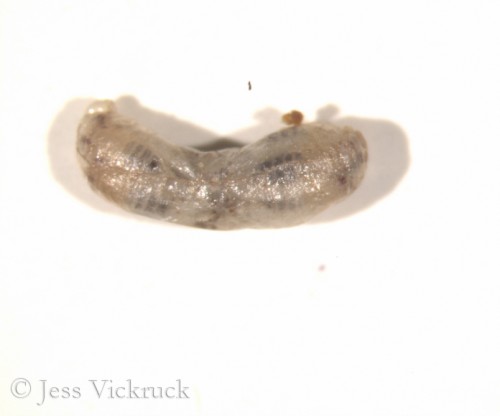
Baryscapus americana larva which have migrated to the anterior and posterior ends of the Ceratina larval skin. You can see their red eyes and black abdomens!
The award for the most organized parasitoid goes to Baryscapus americana (Eulophidae). Several individuals would consume the carpenter bee larva from the inside, leaving only the larval skin. Once they were done eating, the parasitoids would migrate to opposite ends of the host, so that their heads were either at the anterior or posterior end of the remaining bee skin. I could then watch their eyes and bodies change colour before they chewed their way out of the skin as adults. Some individuals also overwintered as prepupa. It was quite a surprise when my un-emerged (and presumed dead) parasitoids began flying around the lab the following spring!
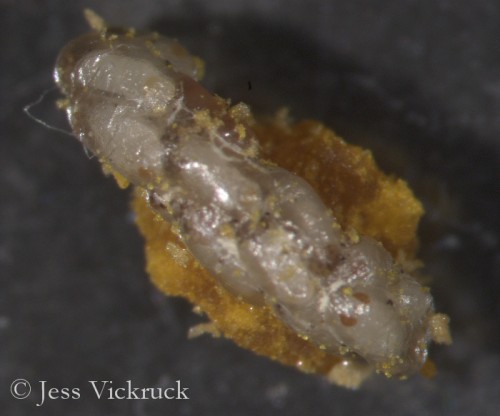
Coelopencyrtus sp. individuals developing inside a Ceratina larva that never got to finish its pollen ball. You can see the eyes changing colour on the individual at the bottom right of the image.
The cutest carnivore was easily a Coelopencyrtus sp. (Encyrtidae). Even though they killed the poor bee as it tried to eat its pollen ball, I couldn’t help but think “Awe, look at how cute they are!” (See the photo to decide for yourself). They also gave you good bang for your buck, as more than 20 individuals would emerge from a single Ceratina larva.
The strangest looking parasitoid was easily Eupelmus vesicularis (Eupelmidae) with its bizarre wings!
Axima zabriskiei (Eurytomidae) took the ‘Booster Juice’ approach to Ceratina consumption. Two individuals could literally suck a bee larva dry in 24 hours! Now that’s a high-protein, liquid diet!!
Probably the creepiest Ceratina hunter I came across were physogastric mites from the genus Pyemotes. One tiny individual (less than 0.5 mm) could effectively paralyze an entire Ceratina pupa. Even teneral adults were at risk. After paralyzing the bee larva or pupa, female mites began to feed on the bee’s haemolymph, causing her abdomen to swell to many times her original size. Hundreds of mature mite offspring would emerge by piercing their way through their mother’s abdomen ‘alien-style’. For some reason, of all the species killing Ceratina, I found this one the creepiest.
A second species of Baryscapus and a parasitoid from the genus Eurytoma (Eurytomidae) round out the natural enemies I observed here in southern Ontario. If anyone encounters any that I haven’t described I would love to hear about it!
Many thanks to my supervisor Dr. Miriam Richards for letting me go out on this tangent and to Dr. John Huber at the Canadian National Collection of Insects and Arachnids for his invaluable assistance with insect identifications! (Without him they all would have remained parasitoid 1, parasitoid 2, parasitoid 3…)
![]() J.L. Vickruck, J.T. Huber, & M.H. Richards (2010). Natural enemies of the bee genus Ceratina (Hymenoptera: Apidae) in the Niagara Region, Ontario, Canada Journal of the Entomological Society of Ontario, 141, 11-26
J.L. Vickruck, J.T. Huber, & M.H. Richards (2010). Natural enemies of the bee genus Ceratina (Hymenoptera: Apidae) in the Niagara Region, Ontario, Canada Journal of the Entomological Society of Ontario, 141, 11-26
OPEN ACCESS HERE

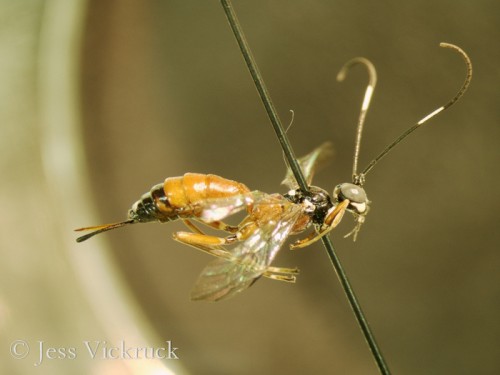
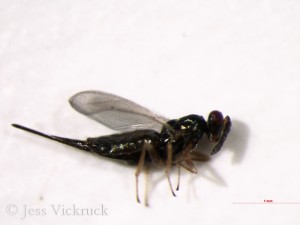
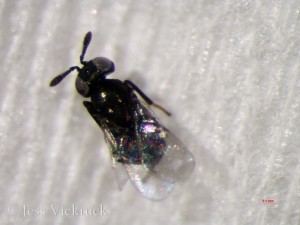
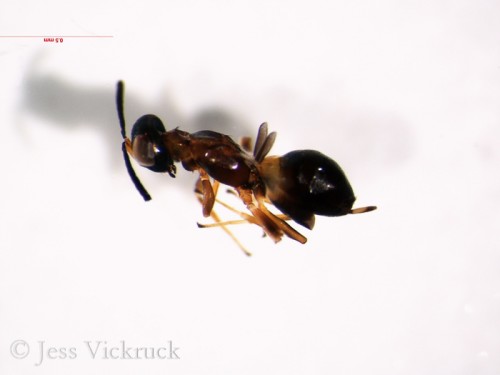
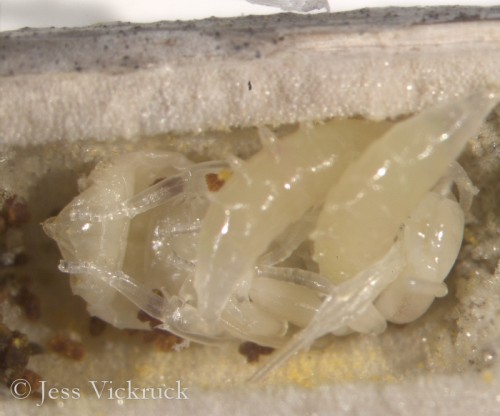
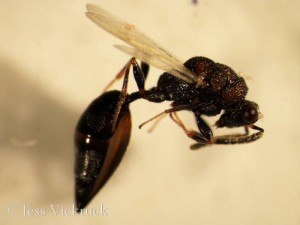
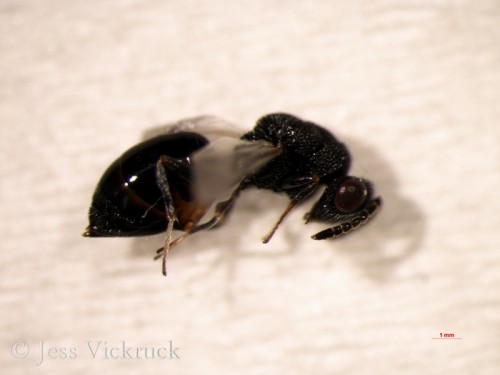
Very interesting post Jess! I am also in love with the parasitoids in my study system, which also includes 1 ichneumonid and various chalcidoids. In fact E. vesicularis is also found in multiple rose galls, apparently they have been recorded in over 100 hosts?
Have you tried sending the Eurytoma sp. to Dr. Michael Gates?
Thanks Miles. Eupelmus vesicularis IS everywhere!! I remember when it emerged thinking “What the heck is this thing?!?” Then at the ESC conference we took a tour of the CNC and there was a picture of one on the wall!
Actually, Michael Gates did help with the Baryscapus and Eurytoma identifications. (I should have thanked him in the blog acknowledgments too…I do in the manuscript).
Nice post. I’ve reared several hundred parasitoid hymenopterans from wood infested with wood boring beetles (several families, but primarily Buprestidae and Cerambycidae). Even though they kill the beetles hosts that I’m after, I’m still amazed at their diversity.
Thanks Ted. Beautiful pictures on your blog by the way! I used to look at every Ceratina immature every day to characterize developmental stages. It was always fun to see a neat parasitoid after looking at hundreds of bee pupae
Where do I get them?